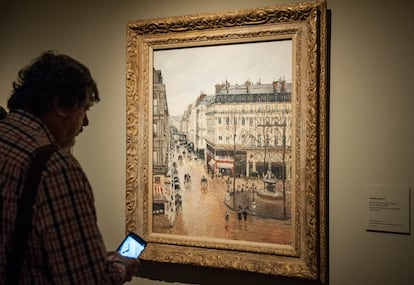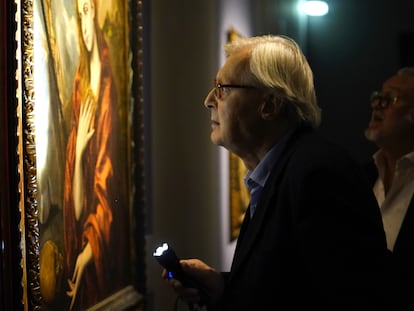‘The Pissarro case’: a moral dilemma for Spain
A California appeals court has ruled that the Nazi-looted painting belongs to the Thyssen Museum, but a dissenting vote argues that the ethical decision for the country would be to give it up voluntarily

The Pissarro case continues. The Cassirer family, which has laid a claim to the Impressionist painter’s piece that is currently owned by Madrid’s Thyssen Museum, will continue to battle for the painting, more than 20 years after the legal process began in U.S. courts. The original owners of the 1897 Camille Pisarro painting Rue Saint-Honoré in the Afternoon. Rain Effect do not agree with the ruling handed down on Tuesday by the California Court of Appeal, which found that the work belongs to the Thyssen Museum. The chances of them winning this judicial battle seem slim. But in this tortuous tale of trials, rulings and arbitration sessions, the German Jewish family has found some hope in the opinion by the California court’s Judge Consuelo Callahan, which has opened up a new line of debate. “Spain should have voluntarily relinquished this painting,” the judge stated. Is Pissarro a legal or a moral question?
Callahan’s opinion directly implicates Spain. It poses a question to the country that, if it reaffirmed its commitment to the Washington Conference Principles on Nazi-confiscated art by signing the Terezin Declaration on Holocaust Era Assets and Related Issues, perhaps it should intervene, putting an end to the continued display of the piece in the Thyssen Museum. The judge addressed the country itself, rather than the museum, because the Pissarro is national heritage, given that it has been owned by the state by 1993 and exhibited in a national arts institution.
The Spanish attorney general’s office appeared in litigation in 2017 in support of the Thyssen-Bornemisza Collection Foundation. At that time, María del Carmen Acedo, one of the state’s attorneys, signed a brief in which she defended the application of an article from the Civil Code. That is to say, the government has formed part of the museum’s defense, and has advocated for Spanish law being applied in the case, as the California court ruled in its decision in favor of the Thyssen Museum. Moreover, as the museum’s managing director Evelio Acevedo has pointed out, the cost of this long legal battle has been funded by a national museum that receives money from the state’s general budget. “There has always been absolute state backing,” he says.
“The Ministry’s current team thinks that the case could have been handled different within the framework of international agreements regarding seizures of works of art by the Nazi regime, but we respect the judicial decision,” say sources from the Ministry of Culture, headed by Ernest Urtasun. No further details were given on the way in which they would have handled years of litigation and the painting’s possible return to the Cassirer family.
“Our opinion is compelled by the district court’s findings of fact and the applicable law, but I wish that it were otherwise,” added Judge Callahan, agreeing with the ruling, but indicating her discomfort with it. “We are not going to enter into personal opinions and this woman, rather than a legal opinion, seems to me to be expressing a personal opinion,” said Acevedo in response to the judge’s comments. The Thyssen spokesperson says that they are complying with the Washington Principles on art confiscated by the Nazis, because in 1976, when Baron Hans Heinrich von Thyssen-Bornemisza bought the work for $360,000 from a New York gallery, he did so “in good faith.” Furthermore, Acevedo says that the Cassirers were already compensated in 1958 when Lilly Cassirer, the first owner of the painting, reached an agreement with the German government, the art dealer Jakob Scheidwimmer and D. Julius Sulzbacher in which she accepted 120,000 Deutsche marks from the German federal government to put an end to the dispute between the parties.
But the Cassirers do not agree, and will appeal Tuesday’s ruling by the California court. Bernardo Cremades, of the Spanish law firm that is part of a case being brought on behalf of several Spanish Jewish organizations, says that “the sentence omits the fact that it is protecting someone — or a government, which is much worse — from keeping art that was stolen or plundered by the Nazis, contrary to all international agreements.”
In an attempt to prevent these litigations from dragging on years, and their cases from being scattered around the world in various courts, where they are likely to be judged in accordance with the laws of each country, the German government, led by Olaf Scholz, announced in 2022 that a central court would judge cases of restitution of art that was plundered by the Nazis. Its aim is to eliminate bureaucratic hurdles and a commission more effective that has so far been receiving claims related to works in pubic collections, such as those of the Thyssen or the Philadelphia Museum of Art. At the end of 2023, the Manhattan district attorney’s office set a precedent in the restitution of work of art stolen by the Nazis by forcing five major U.S. cultural institutions (including the Museum of Modern Art) to return seven drawings by Austrian painter Egon Schiele that were stolen from a victim of the Holocaust.
The Cassirer family, which has spent more than 20 years in this judicial battle, will now have to file a motion for review before the California court circuit panel, and from there would have the option of bringing their complaint to the Supreme Court, which could either agree to review the matter again or let the ruling stand. The chances of this court hearing the case for a second time seems remote.
Sign up for our weekly newsletter to get more English-language news coverage from EL PAÍS USA Edition
Tu suscripción se está usando en otro dispositivo
¿Quieres añadir otro usuario a tu suscripción?
Si continúas leyendo en este dispositivo, no se podrá leer en el otro.
FlechaTu suscripción se está usando en otro dispositivo y solo puedes acceder a EL PAÍS desde un dispositivo a la vez.
Si quieres compartir tu cuenta, cambia tu suscripción a la modalidad Premium, así podrás añadir otro usuario. Cada uno accederá con su propia cuenta de email, lo que os permitirá personalizar vuestra experiencia en EL PAÍS.
¿Tienes una suscripción de empresa? Accede aquí para contratar más cuentas.
En el caso de no saber quién está usando tu cuenta, te recomendamos cambiar tu contraseña aquí.
Si decides continuar compartiendo tu cuenta, este mensaje se mostrará en tu dispositivo y en el de la otra persona que está usando tu cuenta de forma indefinida, afectando a tu experiencia de lectura. Puedes consultar aquí los términos y condiciones de la suscripción digital.
More information
Archived In
Últimas noticias
Half of Scotland is in the hands of 420 property owners
Reinhard Genzel, Nobel laureate in physics: ‘One-minute videos will never give you the truth’
Pinochet’s victims grapple with José Antonio Kast’s rise in Chile
From digital curfews to blocking apps: How technology experts protect their children online
Most viewed
- Pablo Escobar’s hippos: A serious environmental problem, 40 years on
- Reinhard Genzel, Nobel laureate in physics: ‘One-minute videos will never give you the truth’
- Why we lost the habit of sleeping in two segments and how that changed our sense of time
- Charles Dubouloz, mountaineering star, retires at 36 with a farewell tour inspired by Walter Bonatti
- The Florida Keys tourist paradise is besieged by immigration agents: ‘We’ve never seen anything like this’











































